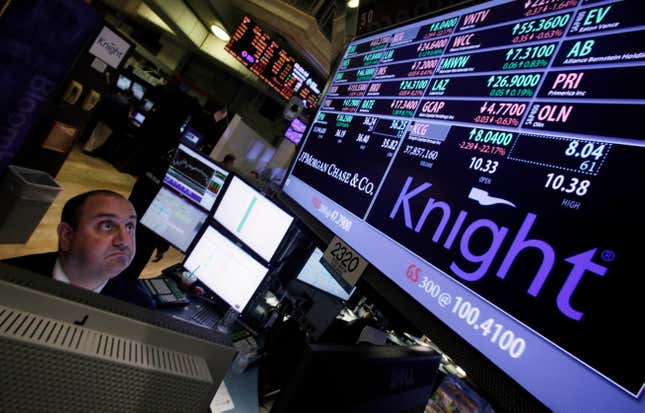
The knee-jerk reaction of legislators worried about “flash crashes” and other sudden market flips caused by high-frequency trading (HFT) algorithms has often, not surprisingly, been to try to constrain their use. The European Parliament and the German government today became the latest to take action over growing concern about HFT: The MEPs on the economic and monetary affairs committee voted to impose a minimum half-second delay on executing trade orders, while Germany’s cabinet approved new regulation on trading firms. They join a slew of countries and regulators that are taking a look at this kind of trading—more or less understood to be the buying and selling of financial securities at high speeds based on algorithms.
Outsiders have claimed that the high-speed race to execute the fastest trades in opaque markets set off market disasters like the May 6, 2010, flash crash and a $440 million trading loss that crippled Knight Capital Group earlier this year. Insiders are concerned that high-speed trading could get out of hand, causing markets to collapse at an inconceivable speed. Limits on how fast orders can be executed—essentially, a promise by trading firms to honor the price they offer on a trade for a minimum time—are one common proposal for limiting market risk.
Yet the data show that, for the most part, HFT benefits long-term investors. And while it has been shown to make markets fall sharply in sporadic events, the real problem isn’t the use of HFT; it’s that the rules haven’t been brought up to date with the technology.
Why you win from HFT
The trend towards HFT is part of a broader change on Wall Street, says Joel Hasbrouck, a professor of finance at NYU’s Stern School of Business. It is a move from markets run by a network of New York traders to a global, electronic network with near-perfect information. In the old days, market specialists would often hail from the same family, and friendships and dinners would be rewarded with preference on the floor. Now quotes are much more accessible. ”It’s not that high-frequency trading is very new, it’s that they have speeded up strategies that have been there for a very long time,” Hasbrouck explains. ”The world of high frequency trading is a lot more open.”
In a July 2012 study, he and co-author Gideon Saar wrote that high-speed machines and their engineers have essentially replaced the human market specialists, or people who used to facilitate the matching of bids and offers on the exchange floor. Under normal market conditions, “increased low-latency activity [i.e., trading with very high speeds] improves traditional yardsticks for market quality such as liquidity and short-term volatility.” In other words, high-speed trading makes for markets that are easier to enter and exit because there are more trading partners (liquidity) and fewer wild swings in the markets (volatility).
This is because HFT firms make high numbers of trades for very small profits. The sheer volume of trades makes it easier for other market players to sell and purchase those securities whenever they want. Further, the fact that HFT firms are in constant competition for the slightest differences in share price across exchanges means that the differences disappear quickly, making the price of publicly available securities all but equal for most long-term investors.
Trading fast in crisis
But it’s true, Hasbrouck and Saar say, that HFT accelerates market crashes sometimes. This has come with some serious risks. The old-time NYSE specialists, they write,
were obligated to stabilize prices and maintain continuous presence in the market. They were subject to restrictions on reaching across the market to take liquidity (destabilizing trades). They were prohibited from interpositioning (trading separately against buyers and sellers who otherwise would have traded directly). The electronic market making firms and other low-latency traders have no such obligations. Their efficiency and lack of obligations could therefore drive traditional suppliers of liquidity out of business by gaining at their expense in normal times. As a result, at times of severe market stress, low-latency traders can simply step away from the market, causing fragility that did not exist in the old model.
In other words, HFT firms have taken on a role in stock exchanges that used to come with a certain responsibility, but nobody is obliging them to fulfill that responsibility now. So far, most regulators have done nothing to change this. Today’s move by the German government was, for the most part in the right direction: the draft bill it approved will require high-frequency firms to be licensed, authorize the use of circuit breakers to stop sudden swings in the market, and impose fees on firms that place too many orders without conducting a trade. (By placing orders and not trading, they can skew the perceived market price.) But these are small steps.
The European Parliament’s decision to put an arbitrary speed limit on HFT, though, is misguided. ”Just because you slow the order down doesn’t mean people aren’t going to be trying to cut to the front of the queue,” argues Adam Sussman, Research Director at the TABB Group, a group closely connected to discussions of HFT at the Commodities Futures Trading Commission. “Slowing markets down probably wouldn’t have any impact on making more stable markets.” Instead, he argues, regulators need to impose “an actual cost-benefit in favor of not blowing up the market.”
The European Parliament committee’s proposal is likely to face resistance, as some European countries have already said they would oppose such a speed limit. But the fact that so many officials are pushing for a speed bump rather than a more comprehensive fix to the problems of HFT is worrisome. Technology is moving forward at a breakneck-pace, and regulators are way behind the pack.